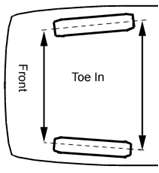Wheel Alignment
In its most basic form, a wheel alignment consists of adjusting the angles of the wheels so that they are perpendicular to the ground and parallel to each other. The purpose of these adjustments is maximum tire life and a vehicle that tracks straight and true when driving along a straight and level road.
Wheel Alignment is often confused with Wheel Balancing. The two really have nothing to do with each other except for the fact that they both affect ride and handling. If a wheel is out of balance, it will cause a vibration at highway speeds that can be felt in the steering wheel and/or the seat. If the alignment is out, it can cause excessive tire wear and steering or tracking problems. The most common angles that are adjusted in an alignment are camber, caster and toe in.
Camber Wear Pattern
 If the camber is different from side to side it can cause a pulling problem. The vehicle will pull to the side with the more positive camber. On many front wheel drive vehicles, camber is not adjustable. If the camber is out on these cars, it indicates that something is worn or bent, possibly from an accident, and must be repaired or replaced.
If the camber is different from side to side it can cause a pulling problem. The vehicle will pull to the side with the more positive camber. On many front wheel drive vehicles, camber is not adjustable. If the camber is out on these cars, it indicates that something is worn or bent, possibly from an accident, and must be repaired or replaced.
Toe in Angle
 The toe measurement is the difference in the distance between the front of the tires and the back of the tires. It is measured in fractions of an inch in the US, and is usually set close to zero, which means that the wheels are parallel with each other. Toe-in means that the fronts of the tires are closer to each other than the rears. Toe-out is just the opposite.
The toe measurement is the difference in the distance between the front of the tires and the back of the tires. It is measured in fractions of an inch in the US, and is usually set close to zero, which means that the wheels are parallel with each other. Toe-in means that the fronts of the tires are closer to each other than the rears. Toe-out is just the opposite.
 An incorrect toe-in will cause rapid tire wear to both tires equally. This type of tire wear is called a saw-tooth wear pattern, as shown in this illustration. If the sharp edges of the tread sections are pointing to the center of the car, then there is too much toe-in. If they are pointed to the outside of the car then there is too much toe-out. Toe is always adjustable on the front wheels, and on some cars, is also adjustable for the rear wheels.
An incorrect toe-in will cause rapid tire wear to both tires equally. This type of tire wear is called a saw-tooth wear pattern, as shown in this illustration. If the sharp edges of the tread sections are pointing to the center of the car, then there is too much toe-in. If they are pointed to the outside of the car then there is too much toe-out. Toe is always adjustable on the front wheels, and on some cars, is also adjustable for the rear wheels.
Other facts every driver should know about wheel alignments.
 A proper wheel alignment should always start and end with a test drive.
A proper wheel alignment should always start and end with a test drive.- The front end and steering linkage should be checked for wear before performing an alignment.
- The tires should all be in good shape with “even wear” patterns. If you have a tire with excessive camber wear, for instance, and you correct the alignment problem that caused that wear, the tire will now be making only partial contact with the road. (see illustration on right)
- Pulling problems are not always related to wheel alignment. Problems with tires (especially unequal air pressure), brakes, and power steering can also be responsible. It is up to a good wheel alignment technician to determine the cause.
Proper alignment improves handling, stopping, fuel economy, and tire wear.
Only one shop in 100 has the expertise and equipment to provide the best alignment services.
